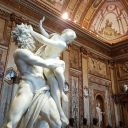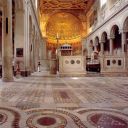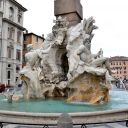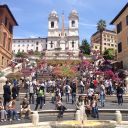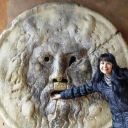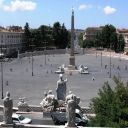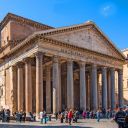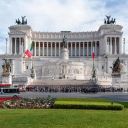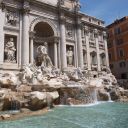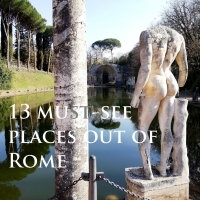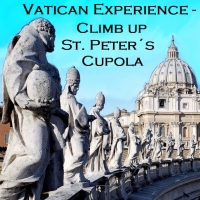
Sights & culture in Rome
We have 26 entries so far.
Galleria Borghese
villa Borghese, Roma
![]() galleriaborghese.beniculturali.it
galleriaborghese.beniculturali.it ![]() info@tosc.it
info@tosc.it
One of the most beautiful small museums in the world. Its collections are housed in a magnificent 17th-century villa and offer a compact course in the Italian aesthetic. In 20 rooms, you are exposed to antiquities, the Renaissance and the beginnings of baroque art. Visits to the Galleria in the northeast corner of the Villa Borghese park are by reservation, which allows you the pleasure of seeing the Bernini masterpieces without being crowded out.
Write a review
Basilica di San Clemente
Via Labicana, 95, 00184 Roma
![]() en.wikipedia.org
en.wikipedia.org ![]() segreteria@basilicasanclemente.com
segreteria@basilicasanclemente.com ![]() +39 06 774 0021
+39 06 774 0021
S. Clemente is a stunning 12th century basilica, built on top of a 4th century church, built on top of a Roman insula and Mithraeum and all these structures are almost complete! To walk down under the basilica is a hugely atmospheric experience: there is a labyrinth of aisles, rooms, you hear and see running water... and you really feel that you are going back in time. Well worth the small entrance fee, but try to avoid school parties if you possibly can!
Write a review
Fontana Quattro Fiumi
Piazza Navona, Roma
![]() en.wikipedia.org
en.wikipedia.org
Located in the middle of Piazza Navona, the Fountain of The Four Rivers (Fontana dei Quattro Fiumi) is the name of a Roman masterpiece made in 1648-1651 by an Italian Baroque sculptor and architect Gian Lorenzo Bernini. The center of the massive reservoir forms an artificial rock of irregular shape from the travertin. On each corner of the reservoir are personified four major world rivers - Nile, Ganges, Danube and Rio de la Plata.
Write a review
Spanish steps (Scalinata di Trinita dei Monti)
Piazza di Spagna, Rome
![]() en.wikipedia.org
en.wikipedia.org
Located in Piazza di Spagna, the Baroque staircase called “Spanish steps” (Scalinata di Trinita dei Monti) is a steep set of steps leading to the church of Santa Trinità dei Monti. They were built in 1723 at the instigation of Pope Innocent XIII. and are one of the most famous staircases in the world. Although there is permanently a lot of people, it is worth climbing up, sit down, relax and enjoy the atmosphere overlooking the fontana (fountain) della Barcaccia.
Write a review
Bocca della Veritá (The Mouth of Truth)
Piazza della Bocca della Verità, Roma
![]() en.wikipedia.org
en.wikipedia.org
Located in the portico of the church of Santa Maria in Cosmedin, Bocca della Veritá (the Mouth of Truth) it is a big marble sculpture of the manlike face with open mouth. Legend says that if you are a liar and put your hand inside the Bocca della Verità, you’ll lose some fingers. The sculpture became famous to English-speaking culture when it was featured in the 1953 film entitled “Roman Holiday” with Audrey Hepburn and Gregory Peck.
Write a review
Piazza del Popolo
Piazza del Popolo, Roma
![]() en.wikipedia.org
en.wikipedia.org
The history of Piazza del Popolo dates back to 1538, when it was the scene of public executions (the last execution in 1826). Today's neo-classical style was designed and built by the architect Valadier in 1815-1816. In the middle of square, there is the Egyptian obelisk Flamine (from the Ramses II period) which was delivered to Rome by the emperor Augustus Caesar. On the southern side, there are the Baroque churches called “twins” of Santa Maria dei Montesanto and Santa Maria dei Maracoli, built by Carlo Rainaldi, Bernini and Carlo Fontana. Although the two churches look almost the same from the outside, the interiors are different.
Write a review
Pantheon
Piazza della Rotonda, Roma
![]() en.wikipedia.org
en.wikipedia.org ![]() +39 06 683 00 230
+39 06 683 00 230
Pantheon (from Greek: pan - all and theoi - gods) is an ancient circular temple in Rome, originally devoted to all the gods, and since 609 dedicated to the Virgin Mary of the Martyrs (Santa Maria dei Martiri, also Santa Maria Rotonda). It belongs to the most important and most preserved ancient temples and buildings in general. The temple was built by Marcus Vipsanius Agrippa (son-in-law of Emperor Augustus) from 29 to 19 BC, in the form of a basilica as a private sanctuary. After 80 AD, the temple - perhaps after the fire - was restored after Emperor Domitian. Today's circular form of the Pantheon dates from the time of Hadrian († 138).
Write a review
Altare della Patria
Altare della Patria, Piazza Venezia, Roma
![]() rome.net
rome.net
The National Monument of Victor Emmanuel II also known as The Altar of the Fatherland (Altare della Patria) is a neo-classical building made of white Brescia limestone (135 m wide and 70 m high), located between piazza Venezia (Venetian square) and Campidoglio (Capitoline hill). The structure was built between 1885 and 1911, according to the design of Giuseppe Sacconi, in honor of Victor Emmanuel II. (the 1st king of a unified Italy) and symbolizes the unification of Italy. The monument holds the Tomb of the Unknown Soldier with an eternal flame, built under the statue of goddess Roma after World War I. For a fee of 10 EUR you can go by lift to the big open-air terrace and enjoy panoramic, breathtaking views of Rome.
Write a reviewFontana di Trevi (Trevi Fountain)
Piazza di Trevi, 00187 Roma
![]() trevifountain.net
trevifountain.net
This impressive, extravagant Baroque monument dominates the small Trevi square located in the Quirinale district and was immortalised in the movie La Dolce Vita with the legendary Anita Ekberg. The masterpiece, built by Niccola Salvi and Bernini. was finished in 1762. The central figure of the fountain is Neptune - God of the sea. He is riding a chariot in the shape of a shell, pulled by two sea horses. Each sea horse is guided by a Triton. One of the horses is calm and obedient, the other one restive. They symbolize the fluctuating moods of the sea.
Write a review-
Swiss Eve Escort
VIP companions -
Via del Corso - shopping avenue
Sights & culture -
Piazza del Popolo
Sights & culture -
Pantheon
Sights & culture -
Fontana Quattro Fiumi
Sights & culture -
Spanish steps (Scalinata di Trinita dei Monti)
Sights & culture -
Bocca della Veritá (The Mouth of Truth)
Sights & culture -
Altare della Patria
Sights & culture -
Rome Escort - Russian girls
VIP companions -
Diamond Escort Agency Rome
VIP companions

